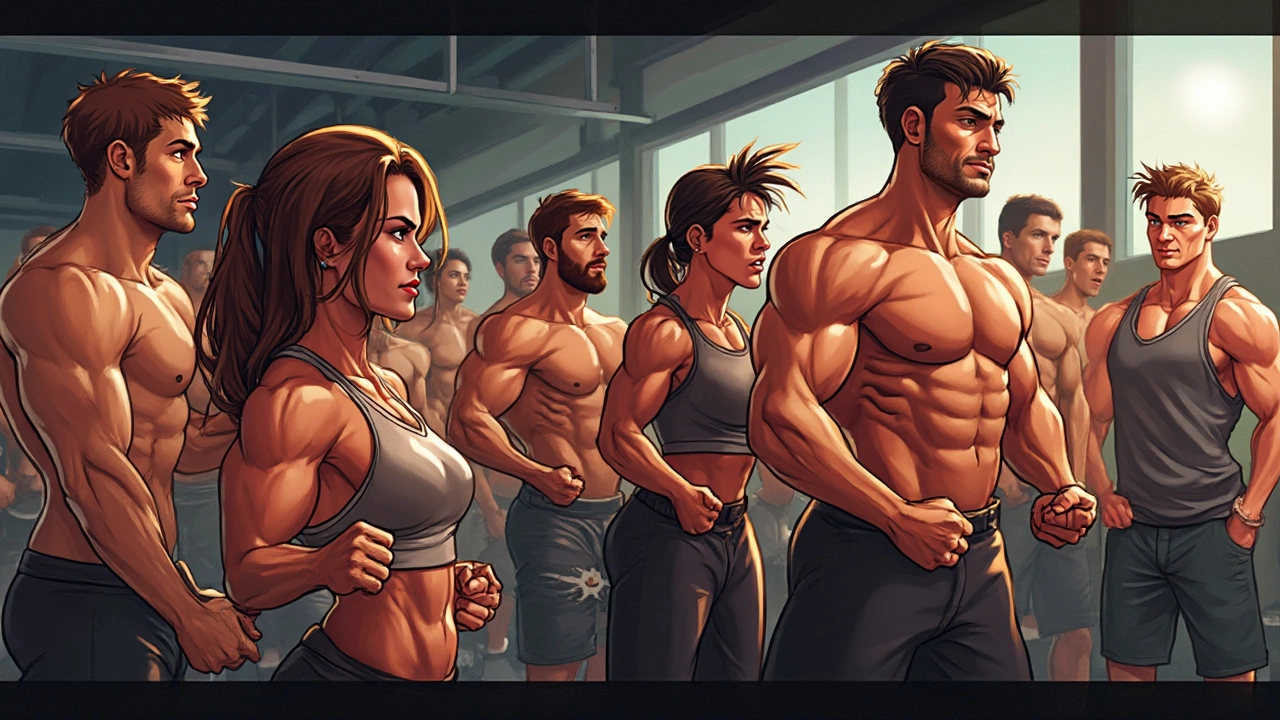When Do Muscles Stop Growing? Unlocking the Secrets

We all know muscles don't just magically appear overnight. But ever wondered if there's a cut-off age for when they stop growing? Well, you're not alone! The truth is, muscles can keep growing or at least maintain their strength for quite a while. Let's dig into the juicy details.
Muscle growth primarily happens during our younger years when our bodies are just bursting with energy and hormones like testosterone and growth hormone are at their peak levels. But hold on! This doesn’t mean those of us who’ve left our twenties behind are out of luck. Your muscles won't just throw in the towel after a certain birthday.
As we age, changes do occur, and they can affect muscle development. But plenty of factors like your training routine, diet, and overall lifestyle play a huge part in keeping those muscles pumped. Ready to find out how to keep your muscles thriving at any age? Let's explore the dynamics of muscle growth and what you can do to make sure they stay strong and healthy.
- The Science Behind Muscle Growth
- How Age Impacts Muscle Development
- Lifestyle Factors That Influence Growth
- The Role of Strength Training
- Nutrition Strategies for Muscle Maintenance
The Science Behind Muscle Growth
So, you’re curious about how those biceps actually get bigger, right? Well, muscle growth, also known as muscle hypertrophy, happens when the fibers in your muscles increase in size. This isn't just a gym story—it's real, backed by science!
When you challenge your muscles through activities like strength training, you're essentially causing tiny tears in the muscle fibers. Sounds painful, but it's a good thing! Your body jumps into repair mode, fixing those tears and, voila, your muscles get a little bigger and stronger each time.
The magic mainly happens because of proteins. Your body increases the production of muscle proteins to patch up those tears. Here's where your diet comes into play. Consuming enough protein helps provide the building blocks necessary for this repair work. That's why folks always rave about getting enough protein!
Now, let's dive into the hormones. Hormones like testosterone, growth hormone, and insulin-like growth factor (IGF-1) are vital for muscle growth. They aid in protein synthesis and help regulate the growth process. As you age, these hormone levels tend to decrease, which might slow down growth a bit. But don't worry—it's not a showstopper if you know how to adapt your training and nutrition.
This is where the strength training part becomes crucial. Engaging regularly in resistance exercises helps trigger those necessary processes in your body that lead to muscle growth. Think of it like sending an RSVP for a muscle-building party, and your muscles love turning up for it!
And hey, if you ever spot one of those scientific studies, they often back this up with stats to show how consistent exercise and proper nutrition can significantly impact muscle development at any age.
How Age Impacts Muscle Development
It's no secret that as we age, our bodies don't quite bounce back like they used to. So what happens to muscle growth? Well, as you get older, your body's ability to build muscle changes, but don't worry, it doesn't just stop altogether.
In your thirties, you might start noticing subtle shifts. This is when muscle mass typically begins to decline at around 3-8% per decade. By the time you're in your forties and beyond, the decline can become more noticeable. But here's the kicker: this doesn't mean you're doomed to frailty! The decline is often due to a decrease in physical activity rather than age itself.
Another factor is the natural drop in hormone levels, like testosterone, which plays a big role in muscle development. This drop means your body has to work a bit harder to build muscles, compared to when you were younger. But don't let this discourage you! With the right strength training and nutrition, you can still make impressive gains and maintain muscle mass.
Let's not forget about the type of muscle fibers. Fast-twitch fibers, essential for strength and power, decline faster with age if not regularly used. On the bright side, regular exercise can slow down this process and even improve endurance and strength.
Check out this factoid: Even folks in their 60s and 70s can increase muscle size by around 5-10% after just a few months of resistance training. How cool is that?
So while aging does throw in a few challenges, it's definitely not the end of the road for muscle growth. Keep active, hit those weights, and stay on top of your fitness game to keep those muscles in shape!

Lifestyle Factors That Influence Growth
Believe it or not, how you live every day can seriously impact your muscle growth age. It's not just about hitting the gym; it’s about everything from your morning routine to bedtime habits. Let’s put the spotlight on some lifestyle moves that can seriously boost your progress.
First up is sleep. Quality sleep isn’t just a luxury; it’s a muscle-building necessity. During deep sleep stages, your body releases growth hormones that are crucial for muscle development. Try getting 7-9 hours of good sleep a night. A regular sleep schedule can do wonders.
Next is stress management. Chronic stress leads to the release of cortisol, a hormone that can break down muscles rather than building them up. Taking time to relax, whether it’s through meditation or a walk in nature, can keep those cortisol levels in check.
Hydration is another biggie. Muscles are about 75% water, so staying hydrated keeps them functioning properly. Aim for at least 8 cups of water a day, more if you’re training hard or it’s particularly hot.
Let’s chat about routine. Consistency in exercise, especially strength training, forms the backbone of muscle maintenance. Regularity is more important than intensity if you want results that stick.
Finally, social factors can’t be ignored. Surrounding yourself with supportive friends or a workout group creates a motivating environment. Plus, swapping tips or even just sharing the journey makes the process more enjoyable.
So, why wait? Start giving these lifestyle tweaks a go. They might just be the game-changer your workout routine needs!
The Role of Strength Training
Alright, let's get into why strength training is your muscles' best friend, no matter what age you are. If you think lifting weights is just for beefy bodybuilders, think again! Strength training is all about helping your muscles grow, get stronger, and stay in top shape.
Here's the scoop: when you lift weights or do any resistance exercises, your muscle fibers actually break down. Sounds scary? Don’t worry; this is where the magic kicks in. Your body rebuilds those fibers and makes them even stronger, allowing for muscle growth and increased strength. This process is vital for anyone looking to enhance their muscle development.
But how much and how often should you hit the gym? Most experts recommend aiming for strength training sessions two to three times a week. Make sure you're focusing on all major muscle groups, including arms, legs, shoulders, and core, for balanced muscle growth.
Not into spending hours sweating it out? The good news is, you don't have to. Start with basics like squats, lunges, push-ups, and dumbbell exercises. Consistency is key. Even short, regular workouts can lead to noticeable results in your strength and muscle mass over time.
Incorporating strength training into your routine does more than just bulk up your muscles. It can boost your metabolism, improve bone density, and even enhance your mood. And for those of us getting wiser (a.k.a. older), maintaining muscle mass can help fend off age-related muscle loss.
So, next time you’re packing your gym bag, remember: you're not just working out. You're investing in your muscle growth and overall health.

Nutrition Strategies for Muscle Maintenance
If you've hit the gym regularly but aren't seeing the muscle growth you want, your diet might be the culprit. Nutrition plays a massive role in maintaining and building muscle, regardless of age. Want to know what should be on your plate?
First up, protein. It's the building block for muscles. As you age, getting enough protein becomes even more critical. Aim for about 1.2 to 2.0 grams of protein per kilogram of body weight each day. Think of lean meats, fish, eggs, or if you’re plant-based, tofu and legumes. Your body needs these to repair and grow muscle tissue, especially after workouts.
Then there are carbs. Despite the bad rap, they’re essential for energy. Complex carbohydrates like whole grains, fruits, and vegetables provide the fuel needed for strength training and recovery. They're great allies in the muscle growth age game.
Don't forget healthy fats. Fats aren’t just for taste; they’re crucial for hormone production, including testosterone, which is essential for muscle growth. Nuts, seeds, avocados, and olive oil should be in your shopping cart.
Hydration can't be overlooked. Muscles are made up of about 75% water, so staying hydrated helps overall function and recovery. Make water your drink of choice to keep muscles healthy.
Consider the timing of your meals, too. Eating the right nutrients before and after workouts can maximize results. A protein shake or a chicken salad can work wonders post-workout.
Here's a quick meal guideline:
- Break it into smaller, balanced meals throughout the day rather than three large ones.
- Include protein in every meal to keep your muscle-building engines running.
- Balance meals with a mix of proteins, carbs, and fats for all-day energy.
To wrap it up, think of nutrition as your secret weapon. Sure, strength training is crucial, but without proper nutrition, your muscles won't get what they need to grow and sustain. So, fuel right, and you'll see the benefits in no time!
